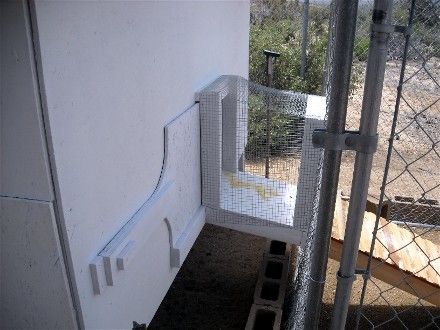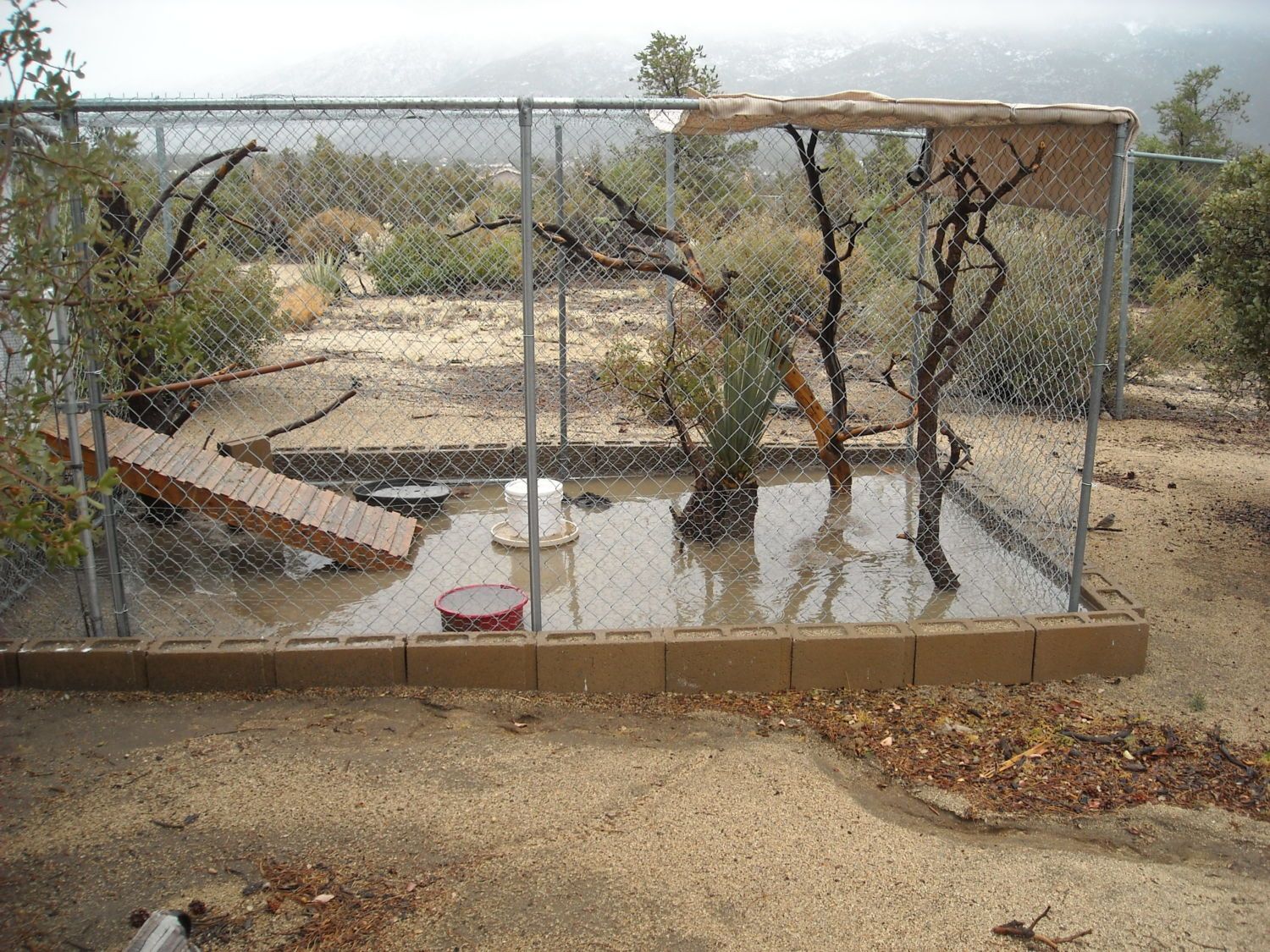I reviewed quite a few websites that talked about coop design, layout, and provided plans (for a fee). I'm pretty handy and decided to wing-it and make the coop fit my space. I've attached some pics of my chicken coop and the attached chicken run. I found a 6'x12' chain link dog run on Craigslist for $30, and the materials for the wooden coop were around $60. I had a lot of scrap lumber in my storage. I based the entire coop on a 48"x96" (4x8) sheet of plywood. This reduced a lot of cutting. It made for 1 sheet for the front, 1 sheet for the back, 2 cut at 72" for the angled roof (scrap used as the overlap at the peak) and 1 cut in half for each end.


I initially designed everything to include a small shrub and succulent that was already growing in that area. But, after working at a zoo for a couple of years, I like to have more of a "natural" enclosure, and less of a utilitarian chicken pen. So, you can see in the photos below that I added several dead tree stumps to the enclosure for the chickens to roost on. And, since I live in rattlesnake territory, it gave them a save place to go IF the enclosure was unsafe.

I kept puzzling over how to seal off the coop from the run without having to go inside either. The panel I used (seen below) is in a track and allows me to slide it closed from the outside to isolate the chickens inside during snow, cleaning of the run (when I need to leave the gate open), etc. or outside when I'm cleaning the coop. The idea came from a pizza board I saw being used at a restaurant. I just cut it from MDF using a jigsaw.
The hardest part was figuring out how to link the coop to the chain link run and make it secure. I have two big dogs, one 14 and doesn't really care about the chickens, the other a 2 year old German Shepherd that just loves to chase bunnies, squirrels and, unfortunately, chickens.
I cut the square opening in the chain link, bent the wires back and twisted them around the existing to prevent the fence from unraveling. Then made a wood frame (on the outside), held it against the chain link and used heavy duty "U" shaped nails to link the chain link to the wood frame. Then outlined the opening with 1/4" square wire mesh, stapled heavily at all connection points. The angles were a bit tricky (passed math with a B, but didn't ace complex geometry), but I worked it out.


The dark steel bar (on the left) is a fence rod that I drove into the ground with a sledge hammer on two opposing corners and wired the coop down. In the high desert we get wind gusts up to 25 mph. The first version of the coop blew over on the second night of building (when the chicks were still in a small pen in the garage for safety). I had to dismantle it and start over.
Inside I provided private egg laying areas using a 12"x48" piece of particle board and a jigsaw to make the openings. I put a very slanted roof over it so the chickens wouldn't try to stand above and poop on those laying eggs. The "roof" has a 3" gap between the edge and the side of the coop to allow for air flow. There is an access panel behind the laying pens so that I can open up that end, collect eggs and clean the area thoroughly. I thought I would use it, but it's just as easy to collect eggs and clean by opening the main door (through which the photo is taken).

I lined the chicken run with cinder blocks to prevent my dogs from digging under the fence. Unfortunately, I didn't take into account the density of high desert sand. After the first heavy rain, the chicken run flooded. When it didn't drain after about 30 hours, I drained it by pushing a hole between 2 of the cinder blocks with a crow bar. Unfortunately, that rain REALLY packed the sand down hard! I used to go in twice a month and scoop out the top 2 inches of sand and replace it with "wild" sand from my other lot (unfenced, seen in the background below) to give them something new to explore. Now it's like raking cement!

Overall, I think the chickens are pretty comfortable in their new home.


Since the original 8 chicks in June 2009, we've lost 4 (it's now June 2012). I'm not sure about how to introduce new chicks to existing full-grown chickens, so hopefully the chickens won't attack the new arrivals.

However, the unfortunate loss did solve one problem... one of the chickens was eating the freshly laid eggs during the night, even though I provided plenty of oyster shell for calcium. Now that one of the whites has died, the eggs are back to the normal 2-3 a day yield. Not bad from only 4 hens.

This is Greta. The queen of the group. Eats first, drinks first, and first to the gate when I come in to the run. Still have the problem with all four chickens losing their tail feathers, but overall they are healthy.


I initially designed everything to include a small shrub and succulent that was already growing in that area. But, after working at a zoo for a couple of years, I like to have more of a "natural" enclosure, and less of a utilitarian chicken pen. So, you can see in the photos below that I added several dead tree stumps to the enclosure for the chickens to roost on. And, since I live in rattlesnake territory, it gave them a save place to go IF the enclosure was unsafe.

I kept puzzling over how to seal off the coop from the run without having to go inside either. The panel I used (seen below) is in a track and allows me to slide it closed from the outside to isolate the chickens inside during snow, cleaning of the run (when I need to leave the gate open), etc. or outside when I'm cleaning the coop. The idea came from a pizza board I saw being used at a restaurant. I just cut it from MDF using a jigsaw.
The hardest part was figuring out how to link the coop to the chain link run and make it secure. I have two big dogs, one 14 and doesn't really care about the chickens, the other a 2 year old German Shepherd that just loves to chase bunnies, squirrels and, unfortunately, chickens.
I cut the square opening in the chain link, bent the wires back and twisted them around the existing to prevent the fence from unraveling. Then made a wood frame (on the outside), held it against the chain link and used heavy duty "U" shaped nails to link the chain link to the wood frame. Then outlined the opening with 1/4" square wire mesh, stapled heavily at all connection points. The angles were a bit tricky (passed math with a B, but didn't ace complex geometry), but I worked it out.


The dark steel bar (on the left) is a fence rod that I drove into the ground with a sledge hammer on two opposing corners and wired the coop down. In the high desert we get wind gusts up to 25 mph. The first version of the coop blew over on the second night of building (when the chicks were still in a small pen in the garage for safety). I had to dismantle it and start over.
Inside I provided private egg laying areas using a 12"x48" piece of particle board and a jigsaw to make the openings. I put a very slanted roof over it so the chickens wouldn't try to stand above and poop on those laying eggs. The "roof" has a 3" gap between the edge and the side of the coop to allow for air flow. There is an access panel behind the laying pens so that I can open up that end, collect eggs and clean the area thoroughly. I thought I would use it, but it's just as easy to collect eggs and clean by opening the main door (through which the photo is taken).

I lined the chicken run with cinder blocks to prevent my dogs from digging under the fence. Unfortunately, I didn't take into account the density of high desert sand. After the first heavy rain, the chicken run flooded. When it didn't drain after about 30 hours, I drained it by pushing a hole between 2 of the cinder blocks with a crow bar. Unfortunately, that rain REALLY packed the sand down hard! I used to go in twice a month and scoop out the top 2 inches of sand and replace it with "wild" sand from my other lot (unfenced, seen in the background below) to give them something new to explore. Now it's like raking cement!

Overall, I think the chickens are pretty comfortable in their new home.


Since the original 8 chicks in June 2009, we've lost 4 (it's now June 2012). I'm not sure about how to introduce new chicks to existing full-grown chickens, so hopefully the chickens won't attack the new arrivals.

However, the unfortunate loss did solve one problem... one of the chickens was eating the freshly laid eggs during the night, even though I provided plenty of oyster shell for calcium. Now that one of the whites has died, the eggs are back to the normal 2-3 a day yield. Not bad from only 4 hens.

This is Greta. The queen of the group. Eats first, drinks first, and first to the gate when I come in to the run. Still have the problem with all four chickens losing their tail feathers, but overall they are healthy.
Last edited:

